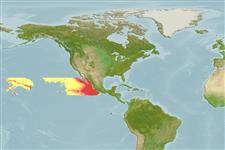>
Gadiformes (Cods) >
Moridae (Morid cods)
Etymology: Laemonema: Greek, laimos = throat + Greek, nema = filament (Ref. 45335).
More on authors: Jordan & Cramer.
Environment: milieu / climate zone / depth range / distribution range
Ökologie
seewasser bathypelagisch; tiefenbereich 666 - 2600 m (Ref. 58018). Deep-water; 28°N - 14°N
Eastern Central Pacific: Mexico.
Size / Gewicht / Alter
Maturity: Lm ? range ? - ? cm
Max length : 11.0 cm TL Männchen/unbestimmt; (Ref. 9316)
Rückenflossenstacheln (insgesamt): 0; Rückenflossenweichstrahlen (insgesamt): 46-51; Afterflossenstacheln 0; Afterflossenweichstrahlen: 39 - 42; Wirbelzahl: 42 - 43. Slender body with elongated tail; depth 12-15% of its length. Branchiostegal rays: 7 (Ref. 36399).
Mesopelagic species (Ref. 9316). Adults usually collected in midwater trawls and in the stomachs of deep-feeding predators (Ref. 31160). Oviparous, with planktonic larvae (Ref. 36399).
Life cycle and mating behavior
Geschlechtsreife | Fortpflanzung | Ablaichen | Eier | Fecundity | Larven
Inada, T., 1995. Merlucciidae. Merluzas. p. 1272-1274. In W. Fischer, F. Krupp, W. Schneider, C. Sommer, K.E. Carpenter and V. Niem (eds.) Guia FAO para Identification de Especies para lo Fines de la Pesca. Pacifico Centro-Oriental. 3 Vols. FAO, Rome. (Ref. 9316)
IUCN Rote Liste Status (Ref. 130435)
Bedrohung für Menschen
Harmless
Nutzung durch Menschen
Mehr Information
ReferenzenAquakulturAquakultur ProfilZuchtlinienGenetikElectrophoresesVererbbarkeitKrankheitenVerarbeitungNutrientsMass conversion
Tools
Zusatzinformationen
Download XML
Internet Quellen
Estimates based on models
Preferred temperature (Ref.
123201): 1.9 - 2.6, mean 2.2 °C (based on 29 cells).
Phylogenetic diversity index (Ref.
82804): PD
50 = 0.5000 [Uniqueness, from 0.5 = low to 2.0 = high].
Bayesian length-weight: a=0.00389 (0.00195 - 0.00776), b=3.11 (2.93 - 3.29), in cm total length, based on LWR estimates for this (Sub)family-body shape (Ref.
93245).
Trophic level (Ref.
69278): 3.3 ±0.5 se; based on size and trophs of closest relatives
Widerstandsfähigkeit (Ref.
120179): hoch, Verdopplung der Population dauert weniger als 15 Monate. (Preliminary K or Fecundity.).
Fishing Vulnerability (Ref.
59153): Low vulnerability (10 of 100).
